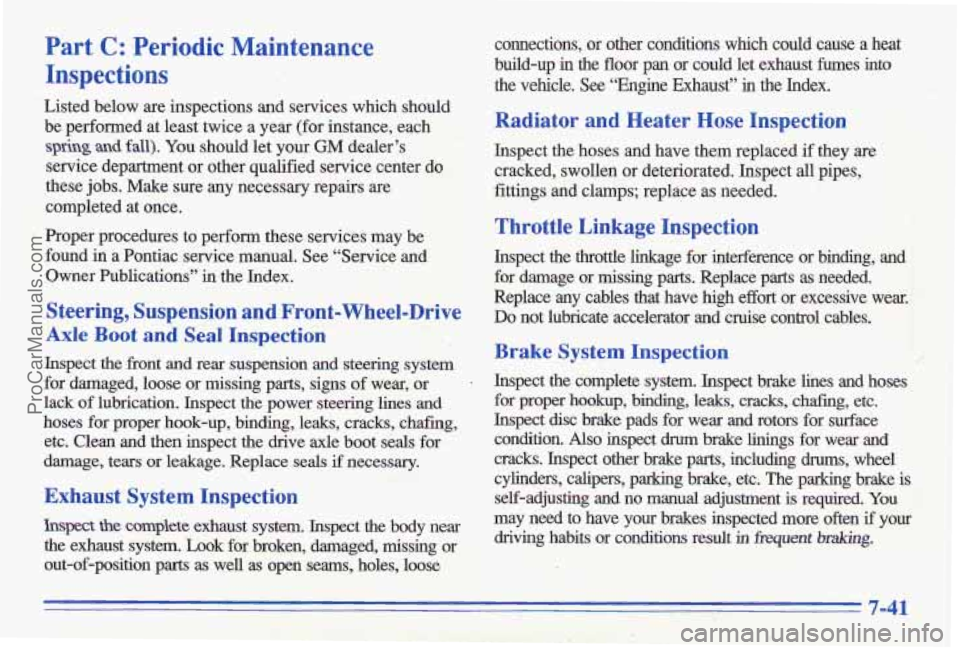Page 252 of 356

With the wrong kind,of fluid in your brake
system, your brakes
may not work well, or they
may not even work
at all, This could cause a
crash. Always use the moper brake fluid.
NOTICE:
Using the wrong fluid can badly damage
brake system park.
For example, just a few
drops
of mineral-based oil, such as engine
oil, in your brake system can damage brake
system
parts so badly that they’ll have to be
replaced. Don’t
let someone put in the
wrong kind of fluid.
If you spill brake fluid on your vehicle’s
painted surfaces, the paint
finish can be
damaged. Be careful not to spill brake fluid on
your vehicle, If you do, wash it off immediately.
See “Appearance Care” in
the Index.
i ‘I I .- ’;/
Brake Wear
Your Pontiac has front disc brakes and sear drum brakes.
Disc brake pads have built-in wear indicators that make
a high-pitched warning sound whew the brake pads are
worn and new pads are needed. The sound may come
and go or be heard all the time your vehicle is moving
(ex’cept when
you are pushing on.the brake pedal
firmly).
The brake wear warning sound means that
sooner
or later your brakes wonY work well.
That could lead
to an accident. When you hear
the brake wear warning sound, have your vehicle
serviced.
6-30
ProCarManuals.com
Page 253 of 356

NOTICE:
I I
Continuing to drive with worn-out brake pads
could result in costly brake repair.
Some driving conditions or climates may cause a brake
squeal when the brakes
are first applied or lightly
applied. This does not mean something
is wrong with
your brakes.
Free movement
of brake calipers and properly torqued
wheel nuts are necessary to help prevent brake
pulsation. When tires are rotated, inspect brake calipers
for movement, brake pads for wear, and evenly torque
wheel nuts in the proper sequence to
GM specifications.
Your rear drum brakes don't have wear indicators, but
if
you ever hear a rear brake rubbing noise, have the rear
brake linings inspected.
Also, the rear brake drums
should be removed and inspected each time the tires
are
removed for rotation or changing. When you have the
front brakes replaced, have the rear brakes inspected, too.
Brake linings should always be replaced as complete
Brake Pedal Travel
See your dealer if the brake pedal does not return to
normal height, or if there is a rapid increase in pedal
travel. This could be a sign
of brake trouble.
Brake Adjustment
Every time you make a moderate brake stop, your disc
brakes adjust for wear.
If you rarely make a moderate ar
heavier stop, then your brakes might not adjust correctly.
If you drive in that way, then -- very carefully -- make
a few moderate brake stops about every 1,000 miles
(1 600 km), so your brakes will adjust properly.
If your brake pedal goes down farther than normal, your
rear drum brakes may need adjustment. Adjust them by
backing up
'and firmly applying the brakes a few times.
Replacing Brake System Parts
The braking system on a modem vehicle is complex. Its
many parts have to be
of top quality and work well
together
if the vehicle is to have really good braking.
Vehicles we design and teSt have top-quality
GM brake
parts in them,
as your Pontiac does when it is new.
When you replace parts
of your 'braking system -- for
example, when your brake linings wear down and you
have to have new
ones put in -- be sure you get new
genuine
GM replacement parts. If you don't, your
6-31
ProCarManuals.com
Page 325 of 356

Part C: -Periodic Maintenance
Inspections connections, or other conditions which could cause a heat
build-up in
the floor pan or could let exhaust fumes into
the vehcle. See “Engine Exhaust”
in the Index.
Listed below are inspections and services which should
be performed at least twice a year (for instance, each
Radiator and Heater Hose Inspection
spxing and fall). You should let your GM dealer’+& ?::. Inspect the hoses and have them replaced if they are
service department or other qualified service center ,:5; 4
cracked, swollen or deteriorated. Inspect all pipes,
these jobs. Make sure any necessary repairs are fittings and clamps; replac\
e as needed.
completed at once.
Proper procedures to perform these services may be
found in a Pontiac service manual. See “Service and Inspect the throt\
tle linkage for interference or binding, and
. ..,..
Throttle Linkage Inspection
Owner Publications” in the Index.
Steering, Suspension and Front-Wheel-Drive
Axle Boot and Seal Inspection
Inspect the front and rear suspension and steering system
for.damaged, loose or missing parts, signs of wear, or
.
lack of lubrication. Inspect the power steering lines and
hoses for proper hook-up, binding, leaks, cracks, chafing,
etc. Clean and then inspect the drive axle boot seals for
damage,
tears or leakage. Replace seals if necessary.
Exhaust System Inspection
Inspect the colillplee exhaust system. Inspect the body near
the exhaust system. Look for broken, damaged, missing or
out-o€-position
parts as well as open seams, holes, loose fordamage
or missing parts. Replace parts
as needed.
Replace any cables that have high effort or excessive wear.
Do not lubricate accelerator and cruise control cables.
Brake System Inspection
Inspect the complete system. Inspect brake lines and hoses for proper
hookup, binding, leaks, cracks, chafhg, etc.
Inspect disc brake pads for wear and rotors for surface
condition.
Also inspect drum brake linings for. wear and
cracks. Inspect other brake parts, including
drums, wheel
cylinders, capers, parking brake, etc. The parking brake
is
self-adjusting and no manual adjustment is required. You
may need to have your brakes inspected more often if your
driving habits or conditions result
in fi-equent braking.
7-41
ProCarManuals.com